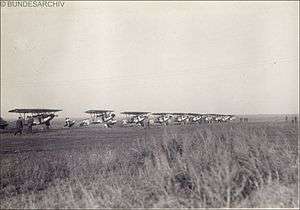Fokker D.XIII
| D.XIII | |
|---|---|
 | |
| Role | Fighter |
| Manufacturer | Fokker |
| First flight | 12 September 1924 |
| Primary user | German Army |
| Number built | 53 |
|
| |
The Fokker D.XIII was a fighter aircraft produced in the Netherlands in the mid-1920s. It was a development of the Fokker D.XI with a new powerplant and considerably refined aerodynamics, and had been designed to meet the requirements of the clandestine flying school operated by the German Army at Lipetsk in the Soviet Union. Like its predecessor, it was a conventional single-bay sesquiplane with staggered wings braced by V-struts. The pilot sat in an open cockpit and the undercarriage was of fixed, tailskid type. The wings were made of wood and skinned with plywood, and the fuselage was built up of welded steel tube with fabric covering.
On 16 July 1925, one of the early examples of a production aircraft was used to set four new world airspeed records: the airspeed record for carrying a 500 kg/1,102 lb payload (265.7 km/h or 165.7 mph), the record for carrying the same payload over a distance of 200 km (264.2 km/h or 164.7 mph), at the same time setting the same records for carrying a 250 kg (551 lb) payload.
Under the cover of a fictitious order from Argentina, the German Army purchased 50 aircraft and arranged to have them transported to Lipetsk via Stettin and Leningrad. There, they equipped the flying school throughout its existence until the German abandonment of the programme in 1933. At that point, the 30 remaining aircraft (including two that had been purchased separately from the original batch) were handed over to the Soviet Air Force.
Operators
- German Army
- Wissenschaftliche Versuchs- und Prüfanstalt für Luftfahrzeuge, Lipetsk
Specifications
General characteristics
- Crew: One pilot
- Length: 7.90 m (25 ft 11 in)
- Wingspan: 11.00 m (36 ft 1 in)
- Height: 2.90 m (9 ft 6 in)
- Wing area: 21.5 m2 (231 ft2)
- Empty weight: 1,220 kg (2,690 lb)
- Gross weight: 1,650 kg (3,640 lb)
- Powerplant: 1 × Napier Lion XI, 425 kW (570 hp)
Performance
- Maximum speed: 270 km/h (170 mph)
- Range: 600 km (380 miles)
- Service ceiling: 8,000 m (26,250 ft)
- Rate of climb: 9.8 m/s (1,930 ft/min)
Armament
- 2 × fixed, forward-firing 7.92 mm (.312 in) LMG 08/15 "Spandau" machine guns in forward fuselage
References
| Wikimedia Commons has media related to Fokker D.XIII. |
- Taylor, Michael J. H. (1989). Jane's Encyclopedia of Aviation. London: Studio Editions. p. 405.
- World Aircraft Information Files. London: Bright Star Publishing. pp. File 894 Sheet 35.
- "The Paris Aero Show 1924". Flight: 771–73. 11 December 1924. Retrieved 2008-03-26.
- "A Fokker Record-Breaker". Flight: 549. 27 August 1925. Retrieved 2008-03-26.
- Johnson, Robert Craig (December 1998). "Planting the Dragon's Teeth: the German Air Combat School at Lipetsk (USSR) 1925-1930". Chandelle. 3 (3). Retrieved 2008-03-26.